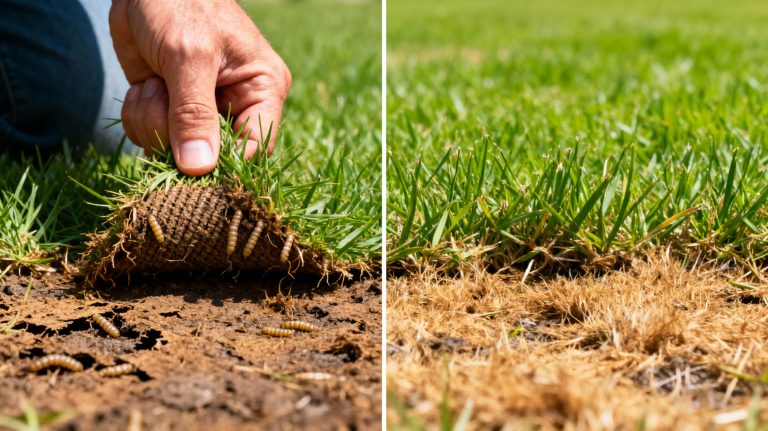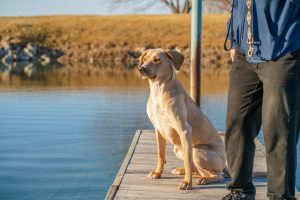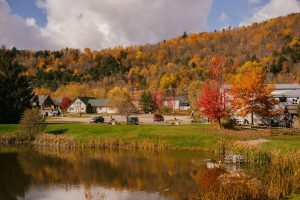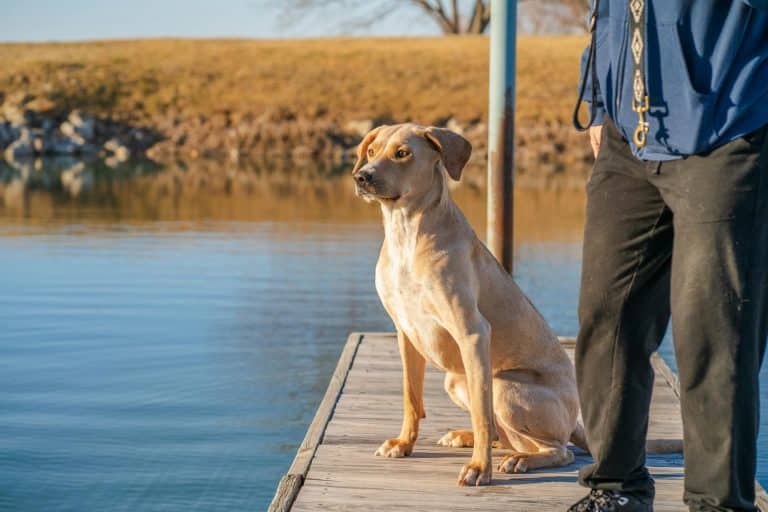Lawns bounce back naturally over time. Most brown patches are fixable if you act this week. You’re trying to figure out if those dead-looking spots are grubs chewing roots or a turf disease spreading through blades.
Right now, do this: at the edge of a brown patch, grab a handful of grass and tug firmly. If it lifts up like loose carpet, you’re looking at grubs. If it stays anchored, keep reading to know what it is. At the underfoot, notice whether the ground feels spongy or solid when you step.
Let’s take a look at it in a bit more detail.
One Minute Tug Test: Grubs Versus Turf Disease
Both grubs and disease can make brown patches, so color alone won’t help. The tug test will. Grubs eat roots, so the sod detaches. Diseases attack leaves and crowns, so the grass stays anchored even when it looks bad.
One more quick cue: early mornings after humid nights, diseases can leave a grayish “cobweb” film on the grass that disappears as the sun hits it. Grubs don’t do that.
Fast Checks to Tell Grubs from Turf Disease
-
Tug the edges of your lawn: if the grass lifts like loose carpet, it’s likely grubs; if it stays firmly anchored, think turf disease or drought.
-
Flip a small square: Cut three sides of a 6-inch square, peel it back, and look. Seeing several C-shaped white grubs right in the root zone is confirmation.
-
Feel the ground: Spongy, unstable turf that shifts underfoot points to root loss from grubs. Firm and springy usually isn’t grubs.
-
Scan the pattern: Irregular, ragged patches that collapse in chunks suggest grubs. Rings, smoke-like crescents, or small, colored spots that merge are typical of diseases.
-
Watch the wildlife: Fresh skunk/raccoon digs or birds pecking frantically at dawn? They’re hunting grubs.
Why Grubs and Turf Diseases Look Alike
Everyone expects “brown = dry,” but grubs and diseases both turn grass brown for different reasons. Grubs sever roots so the plant can’t drink. Diseases rot or spot leaves, preventing them from photosynthesizing.
Drought-stressed lawns also get diseases more easily, and a heavy grub patch can invite fungal issues into the weakened turf. That overlap is why a quick physical test (tug/flip) beats guessing by color.
Pattern Clues: How Grubs Versus Turf Diseases Spread
Grub damage often shows up late summer into early fall as irregular patches that expand quickly and don’t perk up after watering. The edges are the first to fail, then whole chunks tear away.
Turf diseases tend to have more defined shapes. Brown patch makes smoky circles or arcs after warm, humid nights. Dollar spot starts as silver dollar-sized bleached spots that merge into larger areas, especially when nitrogen is low. Pythium looks greasy and matted, worst after hot, sticky evenings and heavy irrigation.
Today: Two Actions for Grubs or Turf Disease
-
If the turf lifted or you found grubs: Apply a fast-acting, curative grub control labeled for active grubs (look for trichlorfon or carbaryl on the label), then water it in well. Press loose sod back down to keep roots shaded. You should notice the patch stops enlarging within 48 hours. A good sign is wildlife losing interest and no new chunks collapsing by day 3-5.
-
If the turf stayed anchored and patterns look diseased: Shift watering to early morning only, skip evening irrigation, and improve airflow (mow at normal height, don’t scalp). If conditions are hot and humid and spots are spreading, use a lawn fungicide labeled for your grass and disease and follow fungicide timing guidelines (common actives you’ll see: azoxystrobin, propiconazole. For greasy, fast moving Pythium, look for mefenoxam). You’ll know it’s working when the edges stop expanding within a few days, and that morning “cobweb” look disappears.
If It’s Grubs: Stop Feeding Now, Then Repair
Plan on two things: stopping the feeding now, then repairing. Curative products only halt further chewing. They don’t regrow roots. Lightly fertilize once feeding stops, keep the area evenly moist, and be patient; some spots will rebound in 2-4 weeks.
Where the sod is gone or shreds when you pull, rake out loose thatch and overseed (cool season lawns) or plug/sod (warm season lawns). Next year, prevent the rerun: apply a preventive grub control in late spring when labels suggest (common actives are imidacloprid or chlorantraniliprole) and water it in.
In most lawns we diagnose, the first clue people notice isn’t the insect, it’s that the lawn feels “mushy” or animals are digging. That’s your cue not to wait.
If It’s Turf Disease: Water at Dawn, Then Treat
Match the fix to the pattern and weather:
-
Brown patch (warm, humid nights. Smoky rings. Fescue, rye, St. Augustine): Water at dawn, not at night. Avoid heavy evening nitrogen. A strobilurin or triazole fungicide (e.g., azoxystrobin, propiconazole) helps break the cycle.
-
Dollar spot (small bleached spots that merge. Low nitrogen): A light nitrogen feeding often helps as much as fungicide. Keep mowing height consistent and blades sharp.
-
Pythium blight (greasy, matted streaks after hot, wet nights): Improve drainage and airflow immediately, reduce watering, and use a product labeled for Pythium (mefenoxam). Act fast, this one runs.
Progress looks like fewer new spots after a few days and fresh green tips pushing through by week two. If the disease keeps marching after you adjust watering and apply a labeled product, it’s time for a closer ID.
Season and Region Notes: Timing and Watering Tips
-
Timing: Grub damage peaks late summer to early fall in many regions. Disease flares during heat and humidity or prolonged leaf wetness.
-
Grass type: Cool-season lawns (fescue, bluegrass, rye) show brown patch/dollar spot differently than warm-season lawns (Bermuda, Zoysia, St. Augustine). The tug test still applies everywhere.
-
Irrigation habits: Night watering is the disease accelerant that almost nobody realizes they’re using. Early morning only.
After 5–7 Days: Stop Guessing and Start Repair
If the area hasn’t stopped expanding within 5-7 days after your first treatment shift, don’t double down blindly. For grubs, resample by flipping a fresh square at the edge. No grubs present means you’re past the insect issue and should repair.
For disease, take clear morning photos of patterns and leaf spots. That visual history is gold for precise ID with common turf disease pictures. Reseeding or resodding is not a failure; sometimes it’s simply faster.
Final Thoughts
If you want backup, whether you DIY or call us, a fast, confident answer saves you money. We diagnose with soil probes and root inspections, check moisture at multiple depths, and can usually confirm grub vs. disease the same week, so you’re not chasing the wrong fix.
Either way, you’ll walk away with a simple plan: stop the cause, set watering right, and get green growth coming back. You’ve got this.













